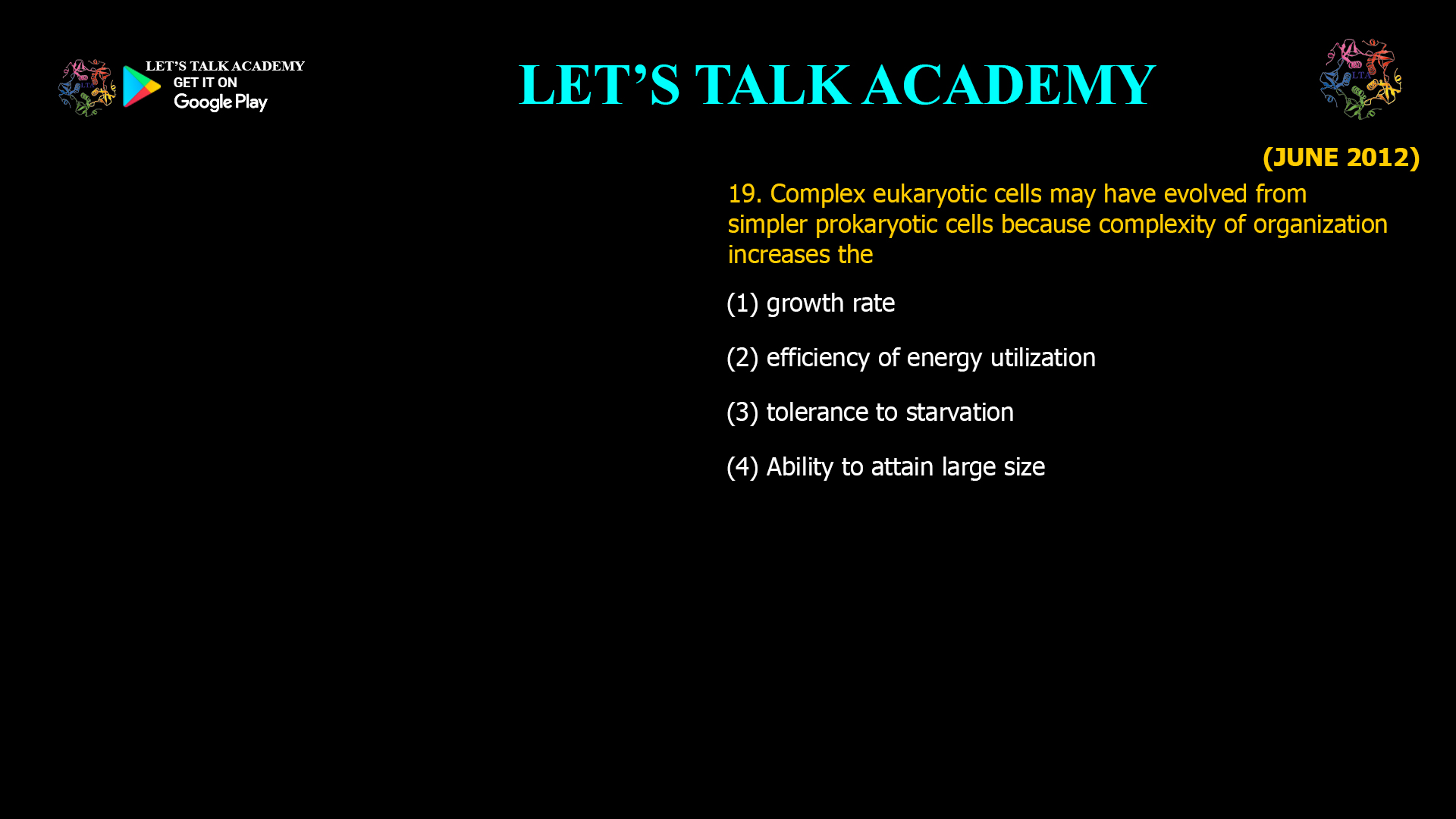- Complex eukaryotic cells may have evolved fromsimpler prokaryotic cells because complexity oforganization increases the
(1) growth rate
(2) efficiency of energy utilization
(3) tolerance to starvation
(4) Ability to attain large size
The Prokaryotic World: Simplicity and Limits
Prokaryotic cells, which include bacteria and archaea, are small, structurally simple, and lack membrane-bound organelles and a true nucleus. Their DNA is typically a single circular molecule floating freely in the cytoplasm. Prokaryotes reproduce quickly through binary fission and are highly adaptable to a wide range of environments.
Despite their success and ubiquity, prokaryotes face certain limitations:
-
Limited Size and Complexity:
-
Prokaryotic cells are generally small and cannot grow beyond a certain size due to constraints in nutrient uptake, waste removal, and DNA management.
-
-
Single Compartment:
-
All cellular processes occur in a single compartment, which can lead to inefficiencies and a lack of specialization.
-
-
Energy Production:
-
Prokaryotes generate energy primarily at the cell membrane, which limits the amount of energy they can produce and use.
-
The Rise of Eukaryotic Complexity
Eukaryotic cells are larger and more complex than prokaryotic cells. They possess a true nucleus, membrane-bound organelles (such as mitochondria, chloroplasts, endoplasmic reticulum, and Golgi apparatus), and a complex cytoskeleton. This internal organization allows eukaryotic cells to perform a wider range of functions and to specialize for different roles within multicellular organisms.
How Did Eukaryotes Evolve?
The leading theory for the origin of eukaryotic cells is endosymbiosis—the idea that a host prokaryotic cell engulfed other prokaryotes, which then became permanent residents as organelles. The most notable examples are mitochondria (which evolved from aerobic bacteria) and chloroplasts (from photosynthetic bacteria). These organelles provided their hosts with new metabolic capabilities, such as more efficient energy production.
The Advantages of Eukaryotic Complexity
The increased complexity of eukaryotic cells offers several advantages over prokaryotic cells:
1. Efficiency of Energy Utilization
-
Mitochondria and Energy Production:
-
Mitochondria, the “powerhouses” of eukaryotic cells, enable highly efficient energy production through aerobic respiration. This process yields much more energy per glucose molecule than prokaryotic fermentation or anaerobic respiration.
-
-
Compartmentalization:
-
Membrane-bound organelles allow for the compartmentalization of cellular processes, reducing interference and increasing efficiency. For example, energy production occurs in mitochondria, protein synthesis in the endoplasmic reticulum, and waste breakdown in lysosomes.
-
-
Specialization:
-
Eukaryotic cells can specialize for specific functions, optimizing energy use for particular tasks within multicellular organisms.
-
2. Ability to Attain Large Size
-
Larger Cells:
-
Eukaryotic cells are typically much larger than prokaryotic cells, thanks to their internal organization and efficient energy production.
-
-
Multicellularity:
-
The ability to grow larger and more complex enabled the evolution of multicellular organisms, where different cells specialize for different functions.
-
3. Growth Rate
-
Controlled Growth:
-
Eukaryotic cells have mechanisms to control their growth and division, which is essential for the development of complex tissues and organs.
-
-
Not Necessarily Faster:
-
While eukaryotic cells can grow larger and more complex, their growth rate is not necessarily faster than that of prokaryotes. In fact, prokaryotes often reproduce more quickly.
-
4. Tolerance to Starvation
-
Resource Management:
-
Eukaryotic cells can store energy and nutrients more effectively, which may help them survive periods of scarcity.
-
-
Not the Primary Advantage:
-
While improved resource management is beneficial, it is not the main reason for the evolution of eukaryotic complexity.
-
Why Efficiency of Energy Utilization Is Key
The primary advantage of eukaryotic complexity is the efficiency of energy utilization. The acquisition of mitochondria through endosymbiosis provided eukaryotic cells with a much more efficient way to generate energy, enabling them to support larger cell sizes, more complex genomes, and specialized functions. This energy efficiency is the foundation for all other eukaryotic advantages, including the ability to form multicellular organisms and to adapt to a wide range of environments.
The Impact on Evolution
The evolution of eukaryotic cells with their efficient energy production and compartmentalized organization led to:
-
Multicellularity:
-
The ability to form complex, multicellular organisms with specialized tissues and organs.
-
-
Diversity:
-
The emergence of a vast array of life forms, from simple algae to complex animals and plants.
-
-
Adaptability:
-
Greater flexibility to adapt to changing environments and to exploit new ecological niches.
-
Key Takeaways
-
Complex eukaryotic cells evolved from simpler prokaryotic cells through endosymbiosis, gaining mitochondria and other organelles.
-
The primary advantage of this complexity is the efficiency of energy utilization, enabled by mitochondria and compartmentalization.
-
Eukaryotic cells can grow larger and form multicellular organisms, but this is a consequence of their energy efficiency, not the main driver of complexity.
-
Growth rate and tolerance to starvation are improved but are not the primary reasons for the evolution of eukaryotic complexity.
-
The correct answer to the question is:
(2) efficiency of energy utilization
Summary Table
| Advantage | Prokaryotes | Eukaryotes | Key to Eukaryotic Complexity? |
|---|---|---|---|
| Growth rate | High | Lower/Controlled | No |
| Efficiency of energy utilization | Low | High | Yes |
| Tolerance to starvation | Moderate | Improved | No |
| Ability to attain large size | Limited | High | Result of energy efficiency |
Conclusion
The evolution of complex eukaryotic cells from simpler prokaryotic cells was driven primarily by the increased efficiency of energy utilization. The acquisition of mitochondria and the compartmentalization of cellular processes allowed eukaryotic cells to produce more energy, grow larger, and specialize for different functions. This energy efficiency laid the foundation for the evolution of multicellular organisms and the incredible diversity of life on Earth.
In summary, the correct answer is:
(2) efficiency of energy utilization




1 Comment
Sonal Nagar
November 9, 2025Efficiency of energy utilization